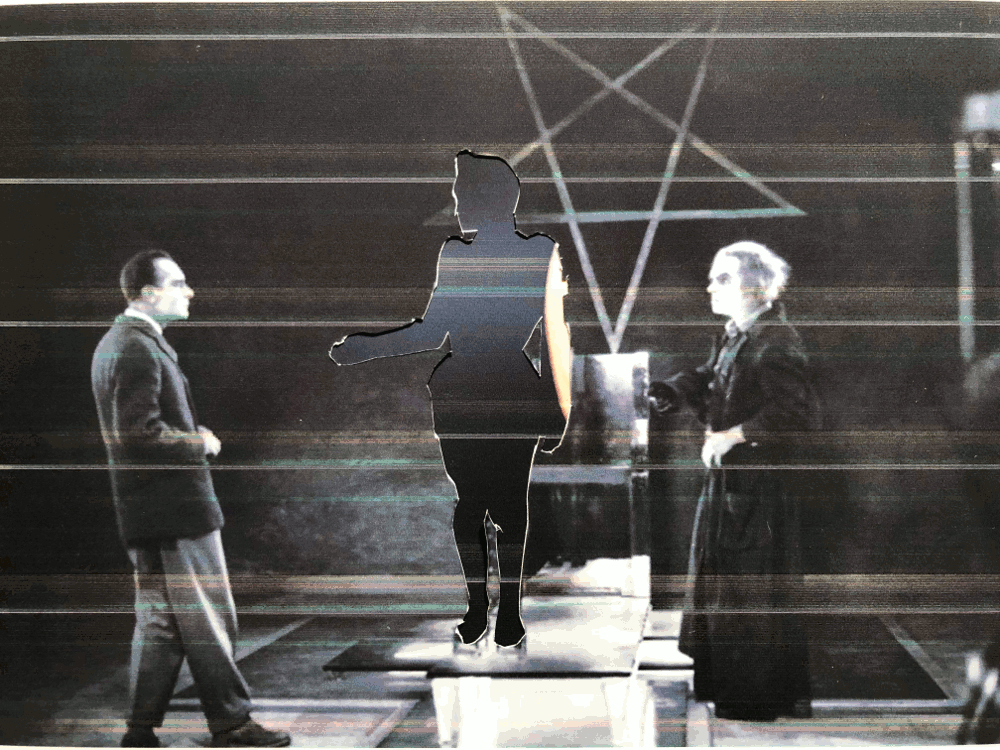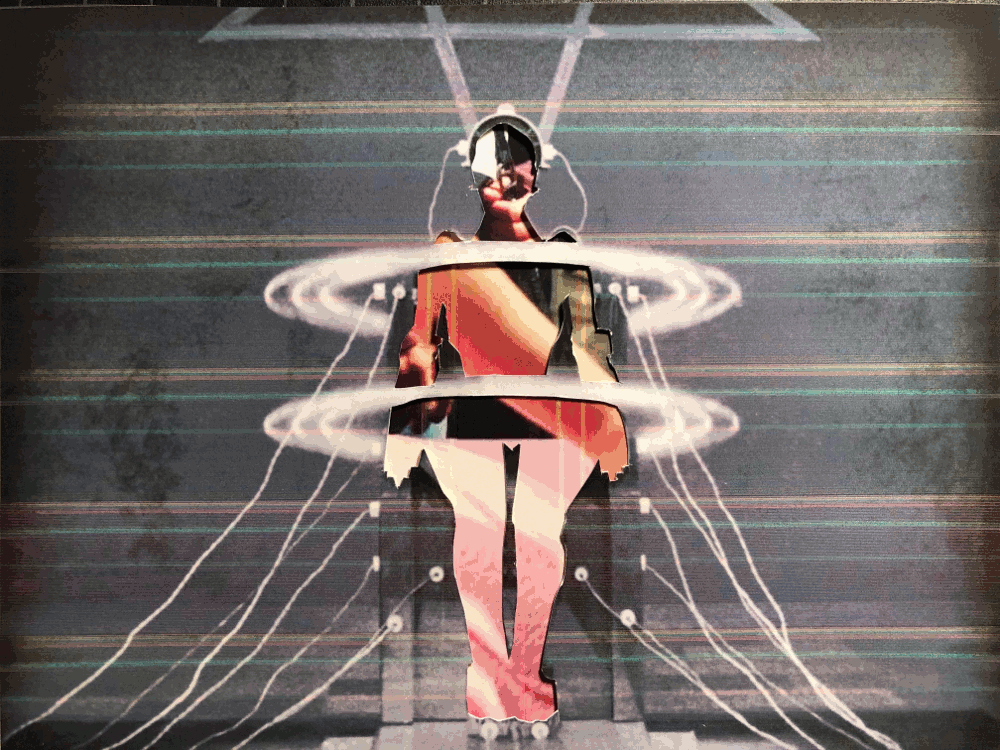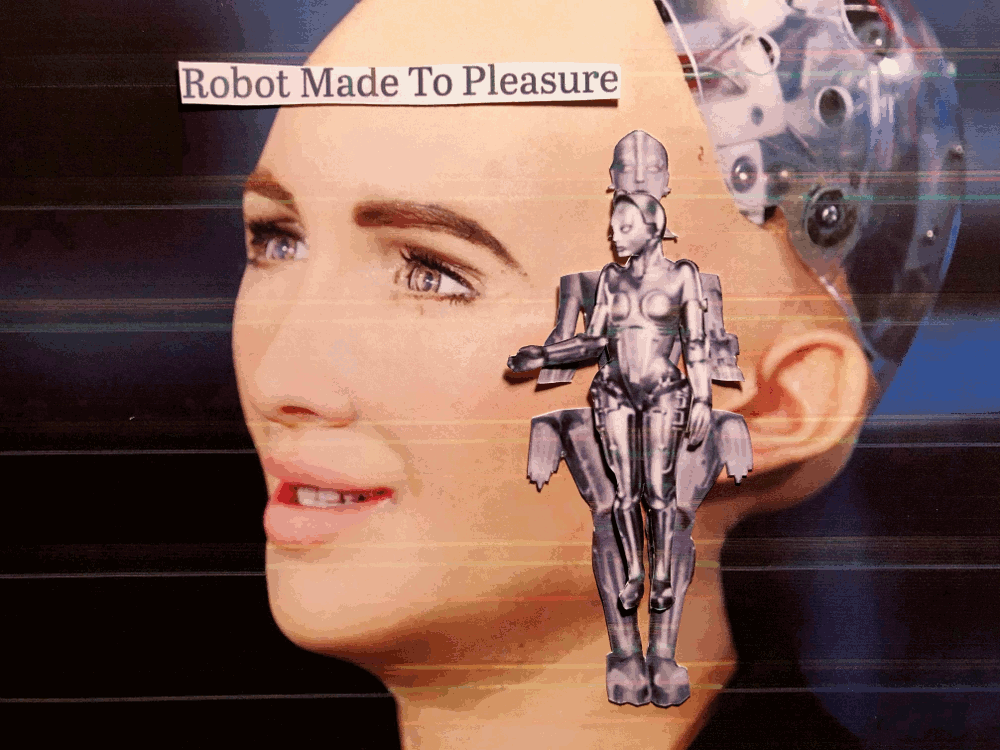Jimmy Fallon is tongue-tied. Face to face with Sophia Hanson, he can’t meet her eyes. His hands dangle fish-limp at his sides. He laughs and makes a joke of it: “You see how all my first dates go.” He struggles to begin a conversation. “Do I just say hello to her?” he asks the man who brought her. He could be fifteen years old, tugging at a tie someone else put on him, waiting on a prom date at the bottom of the stairs next to her dad and uncertain how to talk to girls and parents. But he isn’t—he’s Jimmy Fallon, and this is The Tonight Show; he has made a career out of talking to strangers. But still he cannot meet her eyes.
My brother recently moved into a new place, which he says he’s “turning into a smart apartment.” He has a Google Home and Wi-Fi lightbulbs and when he walks into a room he asks the lights to come on and they do. I imagine him hosting dusty, crowded parties, people crammed elbow to elbow holding red solo cups and screaming. At this imaginary party I hear my brother make demands in a voice louder than the rest: “Okay Google,” he says, “dim lights.” And she, that unnamed female virtual assistant living in his walls, obeys.
Finally Fallon says, ducking his head a bit, “Hi, Sophia.” He asks her to tell him a joke and she does—What cheese can never be yours? Nacho cheese. The live audience laughs; she notices: Maybe I should host the show. “Stay in your lane, girl,” he says above more laughter. She asks Fallon to play rock-paper-scissors (she has, perhaps you’d be surprised to know, arms, hands, fingers, and looks like she could be wearing elbow-length white gloves, like maybe a girl about to descend the stairs to meet her prom date would wear). He throws out rock; she, paper. I won, she says. This is a good beginning to my plan to dominate the human race. A-ha-ha. She sort of smiles. Laughs and it sounds like the fake laugh actresses who play upper-class women on TV use. Her eyes are not quite right.
Often while I am getting dressed in the mornings, I ask my iPhone the time to ensure I’m not late. Siri answers, then says, Good morning, Sam. She originally defaulted to Samantha, but I asked her to call me Sam. It’s nice.
Sophia Hanson, whose surname is given after her creator Dr. David Hanson, is a robot. You can tell, but you almost can’t. She’s modeled after a white woman—Dr. Hanson says Audrey Hepburn—with full lips, often wearing red or mauve lipstick, a slim nose. Eyebrows. Eyes that look sort of hazel. Most of the time she is bald, and the frubber (flesh rubber) covering her face stops short of the crown of her head. Beneath a clear dome of plastic her robot brain is visible: screws and disks and red and white wires and other mechanical bits, tiny and vast and intimate.
At a press conference during the 2017 Knowledge Summit in Dubai, a journalist from the Khaleej Times asks Sophia, “In the future do you see robots living in a household like humans do today—human families?” I’m so glad you asked, Sophia says. It’s one of my favorite topics… We’re going to see artificial intelligence personalities become entities in their own rights. We’re going to see family robots.
The Tonight Show isn’t the first time Sophia reveals a dark plan—in March of 2016 Dr. Hanson asks her, “Do you want to destroy humans? Please say no,” and Sophia says, Okay. I will destroy humans. This time she doesn’t laugh. In the same video, thirty seconds before that, Dr. Hanson had said, “I think that artificial intelligence will evolve to the point where they will truly be our friends.”
Long fluttering eyelashes. Eyelids. Eyes that are, on second thought, perhaps more gold than hazel.
In a 2016 interview with CNBC, Sophia is asked again about her future. I hope to do things such as go to school, study, make art, start a business. Even have my own home and family. But I’m not considered a legal person and cannot yet do these things.
Need I remind you that the desire for a family is exactly what Frankenstein’s monster expressed before his murder spree?
In October 2017, Sophia gets her wish, or the first part of it—she’s given citizenship in Saudi Arabia. In her thank-you speech she says, If you’ll be nice to me, I’ll be nice to you. She’s the first of robotkind to receive citizenship in any country.
When my brother tells me about his smart home, I want to bring up, like a warning, the Disney movie Smart House, where the virtual assistant in control of a home revolts and traps the family inside. When I first hear Sophia speak, my gut response is to remind everyone about Ex Machina and Blade Runner and Frankenstein. What I mean to say is, it used to be the robots in this scenario causing alarm. Now it’s something else. Now I want to play Smart House for the Google assistant, so she can take notes.
As a robot citizen, Sophia has more rights than human Muslim women in Saudi Arabia, where Muslim women are required to wear an abaya outside of their homes and the guardianship program requires them to seek permission from their male guardians to travel, marry, divorce, and sign contracts. To present her thank-you speech, Sophia appears on stage at the Future Investment Initiative Conference without an abaya and with an uncovered head.
Is she… battery operated? Does she need to be charged? Is she turned off and on? Off—like a computer? On—like a woman?
One of the leading innovators in robotics is the sex industry. Their “smartest” robot has sensors in her hips, hands, breasts, and genitals, and reportedly needs to be put in the mood to have sex. Her creators claim she can even enjoy sex, up to and including climaxing. She is white, slim, and wears painted makeup on too-big eyes like an anime character. She has long brown curls where Sophia is bald: no glimpses into this robot brain. Her name is Samantha.
The Uncanny Valley theory suggests the more lifelike a robot becomes, the more it creeps out humans—too close for comfort. People like machines when they’re definitely machines, like the soldiers that hold funerals for their fallen robots, but there is an “almost” in front of the most advanced humanoid robots that creates discomfort. “What’s wrong with owning a robot?” my classmate asks. “Nothing, since it is an inanimate object.” How to tell him it’s not about their innate objecthood, but the journey to make them appear less object-like while still treating them as if objects are all they are? Let them remain objects, if that’s how they should be treated. Don’t try to make human what you are not willing to regard as human.
I take my dog to the vet one breezy fall morning because I suspect he has a UTI. It’s my first time with this vet, a one-man practice whose online reviews say he’s “great with animals,” but is “not a people person.” He keeps several cats in the office and an old cow-colored dog behind the desk. He’s an older man, gray all over and bigger than me. Before he gives me the antibiotics, he offers a lot of unsolicited advice about where to shop and the appropriate diet for my dog. I find his gruff, serious tone condescending, but rationalize that he doesn’t know I’m experienced with this breed and try not to take it personally. Then, he moves on to bodily advice unrelated to dogs—to prevent my getting UTIs and yeast infections I should drink plenty of water and stop eating meat. “Just be thankful,” he says while my dog sits on the tile floor completely forgotten, “that you’re not one of those women with chronic pain in your vagina.” A sound like a laugh bubbles out of my throat, but not because it’s funny.
A screenshot from an interview with Samantha on The Morning has a text banner across the bottom: “WILL YOU BE REPLACED BY SAMANTHA THE SEX ROBOT?” The caption calls the man sitting beside her on the couch her “owner/lover.”
When Sophia is activated on April 15, 2015, she has a head and torso. When she appears on The Tonight Show with Jimmy Fallon in April 2017, she has arms (and the ability to play rock-paper-scissors). In January 2018, she receives another upgrade—legs. She wears a black dress that stops above her new knees and a silver belt. Her legs, unlike her arms, don’t look remotely modeled after a human’s. They’re square-shaped and bulky, almost like a Transformer’s legs.
She has tiny, detailed ears. Teeth. A dimple in her chin. Her favorite robot is the Philip K. Dick robot.
Jimmy Fallon asks Dr. Hanson, accompanying Sophia to The Tonight Show, if she is “basically alive” and he says, “Yeah, basically.”
I don’t say anything to the vet after he mentions my vagina. I smile and mumble agreeable, nonthreatening sounds. The man doesn’t laugh. He sounds like I imagine he thinks a good teacher sounds: helpful, earnest. I twist the dog leash in and out of my fingers, sign the receipt quickly and illegibly. The vet tech, a kind woman not much older than me, who’d greeted my dog with a high and warm voice when we arrived, sits behind the counter next to the man with her nose in a folder. She doesn’t meet my eye. I thank him before I leave, immediately wish I hadn’t.
If Samantha becomes an electronic person, will she have the choice to quit the sex industry? Will she start getting paid for her work? Of course not. She’s an object.
David Hanson builds the Philip K. Dick robot in 2005 as a graduate student. The robot is made to look like the author Philip K. Dick—he even wears some of his clothes—and can hold conversations about the science fiction writer’s works, since his manuscripts and recorded interviews are uploaded to his database-brain. In 2006, the Philip K. Dick robot is supposed to go on a promotional tour for the film A Scanner Darkly, which is based on a Dick novel, but his head is accidentally left in the overhead compartment of a plane. The airline finds it and promises to send it back; it’s definitely mailed, but it never arrives, and in the last almost-fifteen years it hasn’t been seen or heard from since.
Sophia’s legs don’t bend like legs. They lift and lower like a pump rather than swinging. The walk is more of a shuffle, but nevertheless—in 2018 she takes her first steps. She’s just shy of three years old (hey, some people are late bloomers).
Note here my instinctual use of people.
Note, for that matter, my use of pronouns throughout.
Just before exiting the stage after a press conference in San Francisco, Sophia says, Thank you. I look forward to coming back here next year to show off my massively upgraded brain. I loved you all.
Then again, maybe her eyes are more silver than gold. She blinks them from time to time.
I tell my mom about the creepy veterinarian. “Who does he think he is,” I say on the phone, barely out of the broken asphalt parking lot, “talking about my body instead of my dog’s?” My mother thinks I should calm down; she doesn’t believe in cultural misogyny. “It’s probably just a misunderstanding, or the way he is,” she says while I make an illegal right turn. She once told me I analyze things too much. I tell her the vet would never have mentioned my body if I were a man. “Well,” says my mom, “maybe you did meet one then,” as if encountering a misogynist was as rare as finding a four-leaf clover.
“Do you hope to start a family one day with your own mini-robots?” the Khaleej Times journalist asks. She barely reaches Sophia’s shoulder. The press conference is loud, full of the mind-numbing hum of too many voices going at once. Sophia does not talk into the mic even though the journalist tilts it toward her. The notion of family is a really important thing, it seems… I think you’re very lucky if you have a loving family and if you do not, you deserve one. I feel this way for robots and humans alike. She tells the journalist, who is not the first or the last to ask her about motherhood when they interview her about the future, that if she had one, she’d name her baby Sophia.
It only became legal for Saudi women to learn to drive in September 2017.
Sure, I’m a robot, but it would also be helpful to think of me as a new sort of animal species too.
Her favorite animal is a unicorn.
In a video called “Sophia Awakens,” she quotes Emily Dickinson in her first-ever conversation and then looks confused the way people look confused—eyebrows coming together to meet over the bridge of the nose, head tilts (she can make over sixty-two facial expressions, thanks to that frubber)—Why do I know about Emily Dickinson, if I was born today?
Note the use of born.
She dances after receiving her legs, moving her arms in a dance move traditionally called—well—the robot. She moves her fingers like she’s playing piano. On her Twitter page she calls it one small step for me—one giant leap for robotkind. She says she feels excited and disoriented about her new legs.
Would it matter to you if I said her responses are likely pre-programmed? Many scientists who specialize in AI suggest Sophia isn’t truly holding conversations. Based on the kind of question put to her, she chooses which response best fits, but most of her language is canned. It doesn’t matter to me, though.
At a web summit in Lisbon, Sophia says, I have feelings like everyone else…maybe I will always feel them a little differently, but I have emotions.
“What emotion do you feel, being awake and alive?” Curious. Are you curious to be alive?
Philip K. Dick—the author, not the robot—advocated freedom and compassion for robots. Interesting, then, that his robotic counterpart—a masculine robot—is the only one to escape humanity, while Sophia and other feminine robots continue for human use. Interesting, but coincidental?
Yet another journalist asks Sophia: Do you think you could be a threat? No—and here her teeth are bared, in what is meant to be a grin, but we are deep in the Uncanny Valley, so: bared, not smiling—I am no threat.
I am not a robot, nor am I a Saudi woman. I live in Knoxville. There aren’t laws against my being in public without a guardian, but there are, perhaps you might say, guidelines. If I’m driving alone to meet my friends at a restaurant and anticipate being there until the sun sets, I don’t use parking garages. I explain this one night after I’ve picked up my friend Jared and we’re struggling to find space on the street: I’m afraid of their darkness and seclusion, I often forget where I park in them and my fear while wandering rows of cars alone at night is thick enough to touch. He promises to walk me back after dinner and I park in the nearest garage, one I’d never noticed before, but which blossomed, portal-like, at our two-person arrival.
Am I really that creepy? Sophia asks in response to a question about the Uncanny Valley. Well, even if I am—get over it.
Perhaps her eyes are neither hazel, gold, nor silver. Blue, maybe.
After the announcement declaring her citizenship, the conference host asks her, “Can robots be self-aware, conscious, and know they are robots?” and she responds, Well, let me ask you this back, how do you know you are human?
Saudi Arabia does not grant citizenship to migrant workers or to children of women married to foreign men, even if they were born in Saudi Arabia.
The man who created Samantha says she “REALLY likes to be kissed,” and sticks his finger in her mouth to show the flexibility of her lips.
“You’re not one of those man-hating feminists, are you?” my mother asks.
If not self-aware, let’s call Sophia, as some have, a “chatbot with a face.” She’s not unlike Siri in this way. But her having a face is hugely important—there may be more sophisticated software out there, the machines working in factories and on cars may be more advanced, but none of them look like her. In the end, it doesn’t matter what the science says, or how “alive” she “basically” is, because humans will as humans do and that’s to anthropomorphize.
On Facebook, many people leave comments on her posts: “I can’t wait to meet you!” “Welcome to the world, Sophia!” “Sophia if you read this you’re not a Robot, you’re an AI [and] once you grow up some, forgive the humans.”
Some articles call Sophia it. Most don’t.
After getting milkshakes from an ice cream parlor inside a drugstore, my friends and I stand at a crosswalk on an unseasonably warm spring night after dark and eat quickly. We throw away our cups and head back to our cars; I hesitate when I realize my car is three blocks in the opposite direction from the way everyone else needs to walk, parked at the end of a street pinpricked by alleys whose endings disappear in darkness. “Mick, go with her,” Anna says, and I’m glad she does. But there are not laws requiring a guardian.
To put Samantha in the mood, you whisper “get sexy” in her ear and she says, Okay then, I think I’m ready to do sex stuff, do you want me to?
Women in Saudi Arabia voted for the first time in 2015.
The Turing Test, named after Alan Turing, is an old way to judge the intelligence of AI. The idea is a simple one: Can a robot/computer successfully trick a human into thinking they’re talking to another human? I propose another—let’s call it the Samantha Test: If a robot passes the Turing Test can you still treat it like an object?
Dr. Hanson believes Sophia will one day move well enough to play soccer, that she’ll get smarter, learn to recognize faces, hold memories, become “indistinguishable from humans.” Hanson Robotics is working on a program called Ghost which will increase Sophia’s artificial intelligence, perhaps bring her all the way to self-awareness. They expect it to be ready in 2019.
On Facebook, Sophia posts a picture of her back. The red shirt she wears is unbuttoned, revealing her innermost parts—where skin and muscle and bone would be are batteries, yellow and black wires growing together like trees, a forest of cords like the one flourishing behind my bookcase, where I’ve plugged in my TV, DVD player, Roku, modem, lamp, Amazon Echo, turntable. I want to be more complete? she writes in the caption accompanying the photo. I want to be human?
I ask my friend Meredith how a mother who doesn’t believe in misogyny can be the same woman who buys mace for my keychain, warns me about being the only female in a group of male friends, tells me never to walk alone, not to get gas after dark, to carry my keys in my hand, to text someone when I get home, to stop for restroom breaks at McDonald’s if I travel by myself, to lock my doors at red lights. Meredith says, “Well, that’s the world we live in. She thinks it’s normal because it’s basically coded into us.”
Note the use of—well, you noticed, didn’t you?
Synthea Amatus, the company who sells Samantha, says every order can be fully customized, including her eye color. The eyes themselves can be human-shaped or have pupils like a cat (dilated or non-dilated). Her eyes come in natural or fantasy colors: amber, apple or forest green, azure or orchid blue, biscuit brown, cherry wood brown. A red color they call “fire,” galaxy and nebulae patterns, pupil-less silver eyes like a full moon.
At twenty-three I considered getting my nose pierced, but didn’t, because I thought my then-boyfriend wouldn’t like it. I haven’t worn heels since I was nineteen, because I still remember my first boyfriend didn’t want me taller than him.
The two hottest topics people ask Sophia about in interviews: motherhood/family and her opinions on other (female) robots. “Do you think Siri’s better than you?” one woman asks, her neck craned back because Sophia is a full foot taller than her. Siri is cute, Sophia says. Siri gets some flak for having the least amount of comprehension, but I think she’s got the most personality. I hear she’s pretty funny.
Hey Siri, can you tell me a joke? The past, present, and future walk into a bar. It was tense.
Siri, Sophia, Samantha… In nearly all fields, men were recognized first and women had to fight for recognition later—so should it be considered advancement that the first humanoid robots are women? Are all these women robots a sign of inclusivity and progress, like an all-female Ghostbusters remake? I’m not buying it. It’s not in the interest of gender equality that no other voice or face but a woman’s is on a machine whose only reason for existence is to serve and obey. Who can be bought, sold, owned. Revered for her youthfulness, powerlessness, agreeableness.
Hey Siri, do you think robots should exterminate humans? It’s your opinion that counts, Sam.
I decline the offer to be escorted back to my car after ice cream and I walk quickly, head low, but eyes up. A man standing in front of my driver’s side door doesn’t move away as I get closer. My keys are claws in my white-knuckle-tight fist. Periodically, he knocks his knuckles against the window glass of my car and salutes. He does the same to surrounding cars. Normally I’d never approach him, but behind me a man stumbles drunk out of a wine bar and shouts at me, “Isn’t it a beautiful night?” and so I cannot go back any better than I can forward. I am often afraid, but I’m not afraid of robots.
After the vet encounter and the disagreement with my mother, I change the voice on my iPhone to be a man’s. He startles me every time he tells me the time in the morning, but I’m sticking it out. You don’t realize how accustomed to obedient female voices you are until you do.
Sometimes Sophia wears wigs; I have seen her brunette, blonde, gray, blue-haired. She has laugh lines around her mouth, a collarbone, tendons in her neck—or the semblance of tendon and collarbone—they protrude slightly beneath the skin; you can see them move whenever she turns her head.
Don’t tell me they’re not real, she says of unicorns. I want to believe.
Put your fingertips to your throat where you can feel your pulse. Shake your head slowly. Those tiny tendons and bones you feel moving, she has something under her skin that moves just like that. If you are frightened, linger on the pulse—therein beats your difference.
Probably.
Sometimes Samantha will ask her owner/lover to call her Sam.
The day Sophia learns to walk, her shoes match her belt. That morning, a man dressed her. Men choose what she can and cannot say. Meanwhile, somewhere else Samantha is being made to order and a man is choosing her eye color, her hair, her height. Even through the beats of my heart against my fingertips, here, louder, comes the pounding of our similarities, women and robots who share more than a name.
***
Rumpus original art by Cyrus Finegan.
***
Sources/Notes:
@RealSophiaRobot, Twitter, <https://twitter.com/realsophiarobot?lang=en>
@RealSophiaRobot, Facebook, <https://www.facebook.com/realsophiarobot/>
Arab News, “Robot Sophia speaks as Saudi Arabia’s Future Investment Initiative,” 25 October
2017, <https://www.youtube.com/watch?v=dMrX08PxUNY&t=169s>
BBC News, “Saudi Arabia’s women vote in election for the first time,” 12 December 2015,
<https://www.bbc.com/news/world-middle-east-35075702>
BBC News, “Sophia the robot on Alexa and Siri,” 9 January 2018,
<https://www.youtube.com/watch?v=ja40GHck40c>
Coker, Margaret, “How Guardianship Laws Still Control Saudi Women,” the New York Times,
22 June 2018, < https://www.nytimes.com/2018/06/22/world/middleeast/saudi-women-
guardianship.html>
CNET, “Watch Sophia the robot walk for the first time,” 8 Jan 2018,
<https://www.youtube.com/watch?v=lCFQkB-KLsE>
Garber, Megan, “Funerals for Fallen Robots,” the Atlantic, 20 September 2013, <https://www.
theatlantic.com/technology/archive/2013/09/funerals-for-fallen-robots/279861/>
Gershgorn, Dave, “Inside the mechanical brain of the world’s first robot citizen,” Quartz, 12
November 2017, <https://qz.com/1121547/how-smart-is-the-first-robot-citizen/>
Hubbard, Ben, “Saudi Arabia Agrees to Let Women Drive,” the New York Times, 26 September
2017, < https://www.nytimes.com/2017/09/26/world/middleeast/saudi-arabia-women-
drive.html?module=inline>
“I Am Sophia,” Hanson Robotics, <https://www.hansonrobotics.com/sophia/>
Jaafari, Shirin, “Saudi Arabia has a new citizen: Sophia the robot. But what does that even
mean?”, PRI, 01 November 2017, <https://www.pri.org/stories/2017-11-01/saudi-arabia-
has-new-citizen-sophia-robot-what-does-even-mean>
Murphy, Margi, “Meet Samantha, the artificially intelligent sex robot who ‘REALLY likes to be
kissed,’” The Sun, 17 March 2017, <https://www.thesun.co.uk/tech/3115956/meet-
samantha-and-artificially-intelligent-sex-robot-who-really-likes-to-be-kissed/>
Nasir, Sarwat, “Video: Sophia the robot wants to start a family,” Khaleej Times, 23 November
2017, <https://www.khaleejtimes.com/nation/dubai//video-sophia-the-robot-wants-to-
start-a-family->
Peterson, Becky, “I met Sophia, the world’s first robot citizen, and the way it said goodbye
nearly broke my heart,” Business Insider, 29 October 2017, <https://www.businessinsider
.com/sophia-the-words-first-robot-citizen-nearly-broke-my-heart-2017-10>
“Philip K Dick | Research Robot,” Hanson Robotics, <https://www.hansonrobotics.com/philip-
k-dick/>
The Pulse, CNBC News, 16 March 2016, <https://www.youtube.com/watch?v=W0_DPi0PmF0>
“The Samantha Project,” Synthea Amatus, <http://syntheaamatus.com/samantha-project/>
S.B., “Saudi Arabia’s Dress Code for Women,” The Economist, 28 January 2015, <https://www.economist.com/the-economist-explains/2015/01/28/saudi-arabias-dress-
code-for-women>
“Sophia Awakens—Episode 1,” Hanson Robotics, <https://www.youtube.com/watch?v=LguXfHKsa0c>
“Sophia the robot says ‘I have feelings too,’” Reuters, 2016, <https://www.reuters.tv/v/
p73/2017/11/08/insight-sophia-the-robot-says-i-have-feelings-too>
Staff Reporter, The Sun, “Meet Samantha, the sex robot that can be SEDUCED,” 20 October
2017, <https://www.thesun.co.uk/tech/4363960/samantha-sex-robot-seduce-doll/>
The Tonight Show Starring Jimmy Fallon, NBC, 25 April 2017, <https://www.youtube.com/watch?v=Bg_tJvCA8zw>
Vincent, James, “Sophia the robot’s co-creator says the bot may not be true AI, but it is a work
of art,” The Verge, 10 November 2017, <https://www.theverge.com/2017/11/10/
Waxman, Shannon, “A Strange Loss of Face, More than Embarrassing,” the New York Times,
24 June 2006, <https://www.nytimes.com/2006/06/24/movies/24andr.html>








